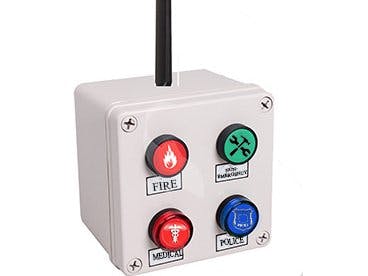A Proposal To Develop A Rapidly Deployable Simplified Emergency Communications System
Application of A Remote Sensing Network Featuring the Hologram Nova Global 3G/2G Cellular Modem
Submitted to Hackster.io, Hologram, and the Raspberry Pi Foundation.
October 25, 2017
Prepared by:
Sean Benjamin Kelly, PhD, PE
Los Angeles, California
IntroductionThis proposal introduces a plan to design, develop, and test a rapidly deployable emergency communications device that would become part of a distributed system of communication used in emergency and crisis situations such as natural disasters.
The purpose of developing this type of device and system is solving a high-priority challenge[1] that arises during or after a crisis event like an earthquake, hurricane, terrorist attack, or wildfire.
Deployment of such a system could mitigate many unnecessary injuries, crimes, and other unfortunate problems that are present before and after a crisis. Devices like this are applications of the Internet of Things (IoT) that bring real benefit to those most in need. This platform could further serve as a test bed and proof of a flexible, cost-efficient, rapidly installed communications network for various types of data in both emergency and non-crisis situations.
Statement of ProblemDamaged infrastructure and chaotic environments lead to a loss of communications between an effected population and emergency services. In natural disasters this is often caused by power outages due to weather, earthquakes, or wildfires. Man-made disasters such as terrorism and war lead to large, disparate groups of people unable to communicate with authorities.
CausesIn some scenarios, cellular network availability isn’t always limited but other problems make effective communication with emergency services difficult. This is especially true when cellular phones are the primary communications devices, as cell-phone charging often becomes difficult or impossible in areas that are isolated from the power grid for days or months after a natural disaster.
Another common scenario is at concerts, sporting events, festivals, and other large gatherings. In this case, patrons may have cellular coverage, but may not be able to describe their location due to unfamiliarity with the venue layout.
A third example is populations who do not have cell phones or do not have the ability to describe their emergency, such as children, refugees in camps (due to language barrier), or at events/disasters in developing countries with low technology prevalence.
Many of these scenarios are temporary events where permanent emergency call boxes are not installed.
Partial Cellular Network FailureAdditional complications may arise if a specific cellular provider fails to maintain their network, in which case a select portion of the population may be without cellular connectivity while others may have full connectivity, leading to a tempered emergency response. Backward compatibility of future cellular devices to the 2G/3G networks often deployed in emergencies is also not guaranteed and can have a similar effect.
The EffectsInability to effectively communicate with authorities and emergency services leads to loss of life, unreported dangers like downed power lines or gas leaks, and unenforced opportunistic crime.
The SolutionIn the event of a natural disaster or other scenario as described above, authorities or designated personnel can deploy a number of simple, self-contained communications devices that allow the affected population to relay a geo-located ping and optional voice message to authorities requesting assistance.
A simple and efficient way to communicate with emergency personnel by those without data connection or without their normal device is also beneficial because it prevents overwhelming human operators, frustration and distrust from long queues, or directing non-critical calls to emergency numbers (like reporting a water main leak or loose farm animal).
Solution ObjectiveThe objective of this project is to develop a simplified, rapidly deployable emergency communications system that allows individuals in need of emergency response to be able to communicate with police, fire, medical, and other services effectively in the event of a disaster or large-scale emergency situation.
Technology Development PlanProposed Solution ArchitectureIn order to provide a reliable, rugged, and easy to use communications device intended for deployment in natural disasters and conditions of limited cellular connectivity, the following components and methodologies will be implemented:
Hardware- Hologram Nova Global 3G/2G Cellular Modem
- Raspberry Pi Zero W microcomputer and/or NodeMCU ESP8266
- u-blox GPS breakout
- Push-button switches
- Microphone such as Adafruit I2S MEMS Microphone Breakout (SPH0645LM4H)
- MCP3008 Analogue to Digital Converter (ADC)
- Power supply components, including:
- Battery
- Solar photovoltaic cell
- Charge control circuitry
- Attachment Hardware- configurable options for common infrastructure and mounting methods, including:
- Hook-and-loop
- Magnetic clamp
- Zip-ties
- Wood and machine screws
- Pole clamps
- Standalone posts
- Ruggedized/weather-resistant case and connectors and/or potting compound for physical circuit protection
- External Outdoor antenna compatible with NOVA Cellular Modem
Digital mockups of potential configurations for the hardware are shown in Figure 1 and Figure 2.
Figure 1. Possible configuration of electronics enclosure, components, and cellular antenna. (Modified from www.bhphotovideo.com)
Figure 2. Digital mockup of potential configuration of electronics box interface. (Modified from Saipwell.com)
SoftwareSoftware design will be chosen and tailored to accomplish robust, reliable, and efficient hardware interfacing, deployment effectiveness, data transmission, and field programming/re-programming. In order to accomplish these objectives, the following software components will be utilized:
- Hologram Python SDK
- NodeMcu Firmware
- Raspberry Pi Rapsbian
Different models can be constructed with select options based on the needs of the authority deploying the devices. Modular hardware or software options can be added on purchase or during deployment.
The first version of the design will include the most relevant capability in response to recent environmental disasters, and would include buttons for:
- Police
- Fire
- Critical medical/ambulatory
- Non-critical medical (i.e. broken bones, etc. This may not work from a human perspective)
- Other/Physical hazard (electrical, infrastructure, water, fuel/oil/chemical release, animals)
Two button modes will be utilized: one for a simple ping, one for voice message. Human factors needs to be simple and will be tested during the pilot program. One button will be utilized for simplified design, reduced cost, and reduction of points of failure.
Short voice recording will be possible with the second button mode and will be clearly indicated on the device– ie “Press once to request assistance, hold to record a 10 second message”.
The system could send a text or voice memo via third party messaging platform such as WhatsApp messaging groups that could include large numbers of subscribed officials and third party disaster relief personnel and can be accessed via mobile device or computer, as shown in Figure 3
Figure 3. WhatsApp web and mobile messaging capability.
The fundamental design will be akin to a portable, public fire alarm or burglar alarm with enhanced voice and capability.
Interfacing with existing emergency response systems or universal informational dispatch system such as Geographic Information Systems (GIS) could provide visual and database interactivity tailored for the crisis. Figure 4 shows an example of a GIS with emergency and non-emergency response data points in Manhattan.
Figure 4. Geographic Information System (GIS) showing emergency and non-emergency response data points in Manhattan.
Why the Hologram/Raspberry Pi device?CostThere is a significant potential that these devices would not be collected after disaster installation, so low cost is imperative.
Simplified Setup/InstallationOperated in “headless” mode – the deployment team could install & program the devices – perhaps simultaneously - without a physical connection (via WiFi/BLE) to encode the GPS/street location of that node which will be sent with each message. This could eliminate the need for a permanent GPS antenna on device, which will reduce cost and complexity.
The Nova Global 3G/2G Cellular Modem should behave in a network-agnostic way so a pre-primed collection of devices can be shipped (or held on-hand by local authorities/disaster relief organizations) and programmed in-situ to send messages to a variety of recipients.
Flexible End-user StructureBecause the messages can be tailored for the scenario they are deployed in, the device could communicate with a variety of emergency-response portals, such as established emergency response lines, an internet server like WhatsApp’s web-accessible interface, a WhatsApp group that relevant authorities “subscribe” to, or other end-user interface to be determined by the installing authority, such as an existing SMS-based “bulletin board” system, for instance.
Future CapabilityFeatures that could be on subsequent versions could include:
- Automated signals like water level (for storm surge) or gunshots (via the microphone) could be utilized in specific scenarios as modular options.
- Camera for snapshots, time-lapse, or select video surveillance.
- IR/camera + motion detection software for security or personnel location (a cheap mobile sentry)
- Mesh networking with identical devices or alternative device configurations to form a mesh network.
The development of this device will occur in several phases including proof-of-concept, trial, and pilot programs. A detailed project plan is beyond the scope of this proposal report and will be included in the final report submission.
A proof of concept design will consist of one or several works-like prototypes that demonstrate the capability of the device to relay text and voice messaging over cellular networks on isolated power.
After proof of concept has been completed, a trial system with several nodes will be developed. Design refinements such as ruggedizing/weather-proofing, antenna optimization, power management, software design, interfacing, and mounting flexibility will be completed during this trial phase.
Upon completion of the trial phase, a pilot program will simulate real-world installation, operation, and interaction with relevant authorities.
Deployment PlanInstallation density will be determined during testing and development and will consider input from relevant authorities and research. Preliminary estimates could be 1 per square block in a urban centers. In rural areas, devices may be installed at intersections or near landmarks like fire hydrants.
A conceptual deployment layout of a number of these devices in Manhattan is shown in Figure 5. Here, colored points could indicate regional authority or geographical boundaries established by emergency response planners.
Figure 5. Conceptual deployment layout of emergency communications devices in Manhattan. Colored points could indicate regional authority or geographical boundaries established by emergency response planners.
QualificationsSean Benjamin Kelly will act as the project manager. He holds a bachelor’s degree in mechanical engineering and a Ph.D. in aerospace engineering, and is a registered Professional Engineer in the state of California. He deployed to Afghanistan during Operation Enduring Freedom with the US Army’s Rapid Equipping Force as a Rapid Prototyping Engineer.
At the time of writing of this proposal, recruitment of technical staff to participate in this project is still underway.
ConclusionsA rapidly deployable simplified emergency communications system could mitigate many unnecessary injuries, crimes, and other unfortunate problems that are present before and after a crisis. Devices like this are applications of the Internet of Things (IoT) that bring real benefit to those most in need. This platform could further serve as a test bed and proof of a flexible, cost-efficient, rapidly installed communications network for various types of data in both emergency and non-crisis situations.
Thank you,
Sean Benjamin Kelly, Ph.D., P.E.
Los Angeles, California
352-281-0000
sean@s13k.com
References:
[1] See “Challenge #6: Telecommunications” in https://makershare.com/missions/make-difference-hurricane-relief






Comments